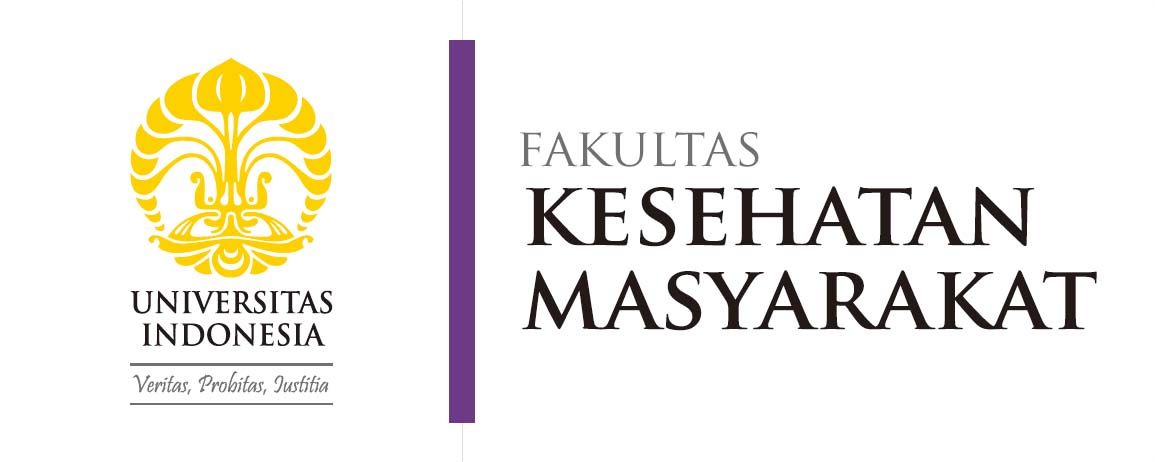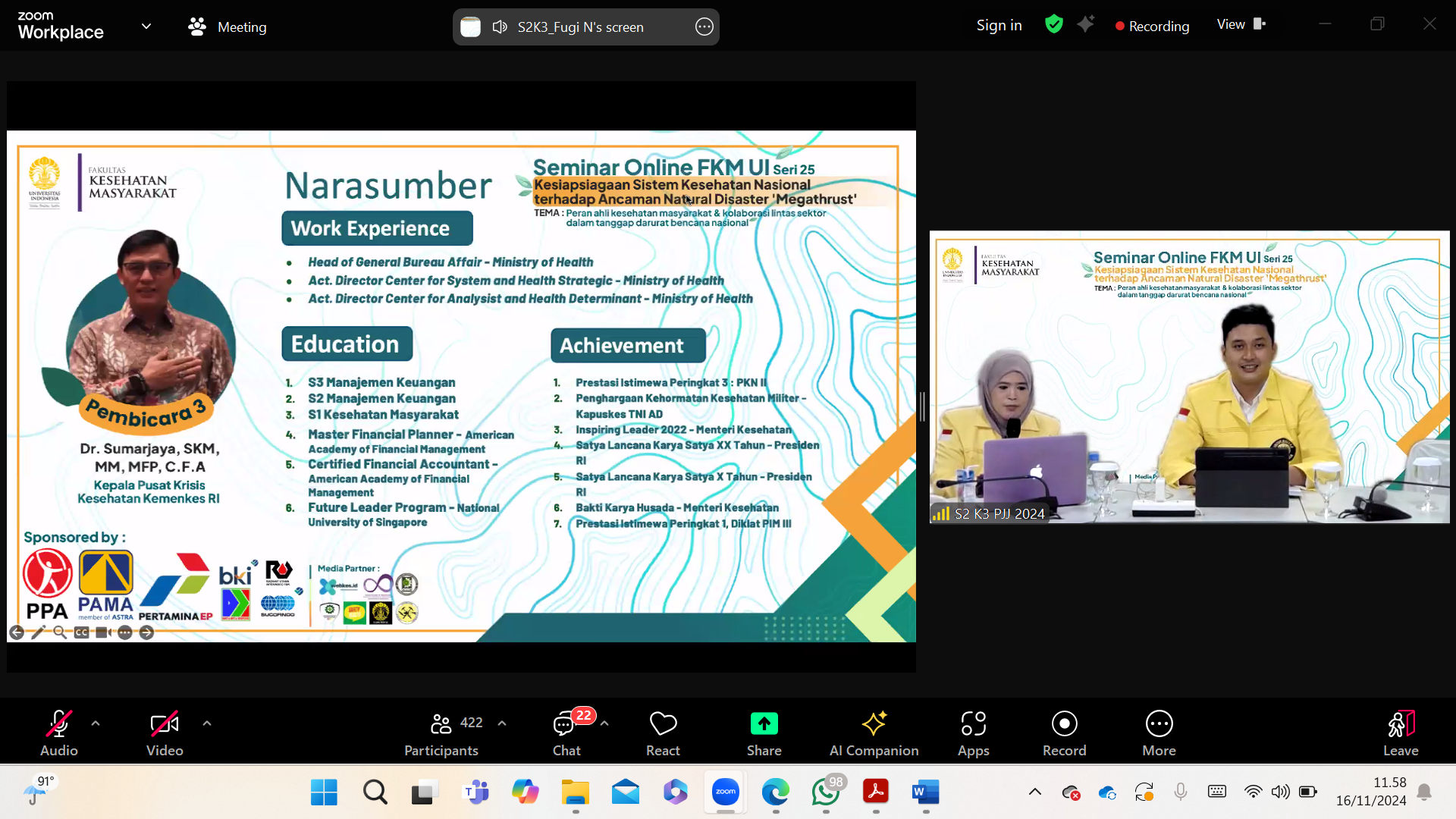The Master of Occupational Health and Safety (OHS) program at the Faculty of Public Health (FPH) Universitas Indonesia (UI) successfully held the 25th series of the FPH UI Online Seminar (Semol) on Saturday, November 16, 2024. This seminar discussed the preparedness of the national health system in facing megathrust natural disaster threats. The seminar, moderated by Dr. Fetrina Lestari, S.K.M., M.K.M., provided an important discussion platform for over 400 participants, ranging from academics to practitioners, to enhance awareness and prepare strategies for disaster risk management in Indonesia. The discussion, titled “The Role of Public Health Experts and Cross-Sector Collaboration in National Disaster Emergency Response,” also highlighted the importance of cross-sector collaboration in building resilience against disasters.
In her opening remarks, Prof. Robiana Modjo, S.K.M., M.Kes., emphasized the relevance and urgency of this topic. “This seminar not only serves as a platform to enrich academic knowledge but also reflects the commitment of OHS students at FPH UI, who are currently taking the Intermediate Public Health course. They strive to make a tangible contribution to the issues currently attracting wide attention,” said Prof. Robiana.
Prof. Robiana also highlighted Indonesia’s strategic position in the Pacific Ring of Fire, making it one of the countries at high risk for natural disasters, particularly earthquakes and tsunamis. Therefore, preparedness is considered a key element in minimizing the negative impacts of potential disasters.
According to Prof. Dr. Irwan Meilano, a geodesy earthquake expert and Dean of the Faculty of Earth and Technology Sciences at Bandung Institute of Technology, Indonesia’s position within the Pacific Ring of Fire makes it highly vulnerable to earthquakes and tsunamis. As a result, Indonesia needs to focus on disaster mitigation efforts, which are key to reducing risks and impacts. Prof. Irwan explained the concrete actions already taken, including his involvement in the disaster mitigation community, such as the formation of emergency response teams playing a crucial role in disaster response. “These teams collaborate with local governments to facilitate post-disaster recovery, provide logistical support during crises, and establish long-term aid programs. This aims to ensure the continuity of affected communities,” Prof. Irwan stated.
Research on major subduction zone earthquakes (GBS) has also been a priority for Prof. Irwan. He noted that accurate research forms the foundation for effective mitigation strategies. “This research opens the door for collaboration involving stakeholders from various sectors. Mitigation strategies include business continuity planning (BCP), infrastructure reinforcement, workforce training, and support from local governments,” he explained. Furthermore, the emergency and crisis management framework consists of three levels. “Level 1 (Crisis) focuses on coordination and prevention to prevent further deterioration. Level 2 (Emergency) requires the activation of additional resources, while Level 3 (Urgent) demands a rapid response to mitigate significant impacts,” Prof. Irwan elaborated. He emphasized that preparedness is not only the responsibility of the government but also requires active roles from communities, educational institutions, and the private sector. “Our preparedness is not just about tools or infrastructure but also knowledge-based collaboration focused on solutions. With this approach, we can create a more resilient and adaptive system,” he concluded.
Prof. Dra. Fatma Lestari, M.Si., Ph.D., provided a perspective on the risks of megathrust earthquakes and their impacts on public health. As a Professor at FPH UI and Director of the Disaster Risk Reduction Center, she stressed that megathrust earthquakes not only pose physical threats but also have serious consequences for public health. “This threat should not be underestimated as its impacts cover various aspects, ranging from infectious diseases to mental health issues,” she said.
Prof. Fatma explained that post-disaster conditions often create environments vulnerable to the spread of infectious diseases such as diarrhea, cholera, and respiratory infections. A key factor exacerbating the situation is limited access to clean water, damage to sanitation facilities, and overcrowding in evacuation shelters. “Poor sanitation and hygiene pose significant health risks, especially for communities affected by mass evacuations,” Prof. Fatma added. Additionally, she highlighted the high incidence of psychological trauma and mental health disorders such as Post-Traumatic Stress Disorder (PTSD), anxiety, and depression among disaster victims. “Psychosocial support is essential to help survivors cope with trauma and rebuild their mental resilience,” Prof. Fatma stressed.
Strategic analysis regarding megathrust earthquake threats and health crisis mitigation measures was also presented by Dr. Sumarjaya, S.K.M., M.M., MFP., CFA., Head of the Health Crisis Center at the Ministry of Health of Indonesia. Dr. Sumarjaya explained that megathrust earthquakes occur along subduction zones, which have the potential to cause massive earthquakes and tsunamis. “Historical earthquakes in Indonesia, such as the 2004 Aceh earthquake, 2005 Nias earthquake, 2009 Padang earthquake, and 2010 Mentawai earthquake, demonstrate the urgency of this risk,” he said. According to Dr. Sumarjaya, it is important to use earthquake potential data as the basis for developing mitigation and preparedness measures.
As part of a systemic effort, Indonesia’s health system transformation from 2021 to 2024 provides a foundation for improving emergency resilience. Dr. Sumarjaya emphasized that lessons from the COVID-19 pandemic offer valuable insights. “The pandemic showed that our national health system still has weaknesses in testing, tracing, and tracking, as well as difficulties in mobilizing resources such as healthcare facilities, medical supplies, and healthcare personnel,” he explained. As a result, Dr. Sumarjaya proposed strengthening the health system through penta-helix collaboration, involving the government, community, academia, the private sector, and the media.
Health crisis management must also be conducted in a structured manner, from the pre-crisis to post-crisis phase. In the pre-crisis phase, the formation and implementation of health clusters aim to reduce crisis risks. Meanwhile, in the crisis phase, the command system is activated to prevent deaths, reduce disabilities, and maintain essential healthcare services. “After the crisis, our goal is to rebuild a better, safer, and more sustainable system,” Dr. Sumarjaya added.
The seminar was also attended by industry figures such as Adam Maryanto, Manager of HSSE Operations at Zone 7 Pertamina EP; Ryan Saputra from PT Pamapersada Nusantara; and M. Osaegi Restu A from PT Putra Perkasa Abadi. Their participation enriched the discussion with practical insights, underscoring the synergy between the government, academia, and the private sector in strengthening national emergency response resilience. (DFD)

